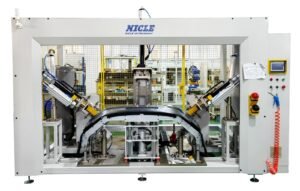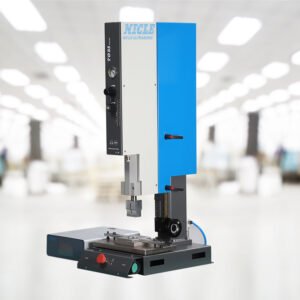Introduction to Plastic Joining Technologies
In advanced manufacturing, ultrasonic welding and vibration welding stand out as leading methods for bonding thermoplastics. Both techniques eliminate the need for adhesives or mechanical fasteners, offering faster production cycles and cleaner joints. This comprehensive guide examines:
- Core operational principles
- Shared advantages over conventional welding
- Critical technical distinctions
- Overlapping and unique industrial applications
Section 1: How Ultrasonic Welding Works
Principle: High-frequency vibrations (15–70 kHz) generate localized friction heat at the joint interface through a piezoelectric converter.
Process Breakdown:
- Serrage: Components are secured under pressure.
- Energy Delivery: Ultrasonic waves transmit via a titanium horn (sonotrode).
- Melting Phase: Friction melts thermoplastic materials at the contact point.
- Solidification: Pressure maintains until the molten layer cools.
Key Equipment:
- High-frequency generator (20–40 kHz typical)
- Titanium booster and horn for amplitude tuning
- Pneumatic or servo-driven press system

Section 2: Fundamentals of Vibration Welding
Principle: Linear or orbital motion (100–300 Hz) creates macroscopic friction between parts, generating heat for bonding.
Process Stages:
- Alignement: Components are fixed in a custom jig.
- Oscillation: One part vibrates laterally (1–5 mm amplitude).
- Fusion: Continuous friction produces a uniform melt layer.
- Fusion: Vibration ceases; parts bond under sustained pressure.
System Components:
- Electromechanical drive unit with frequency modulation
- Hydraulic clamping system
- PLC-based control interface
Section 3: Key Similarities Between Ultrasonic and Vibration Welding
-
Adhesive-Free Bonding
Both methods create molecular-level fusion, eliminating glue-related contamination risks. -
Thermoplastic Focus
Optimized for polymers like ABS, polycarbonate, nylon, and polyethylene. -
Rapid Processing
- Ultrasonic: 0.1–1 second cycles for small components
- Vibration: 2–10 seconds for large parts
-
Hermetic Sealing
Produce leak-proof joints for medical devices and fluid containers. -
Automation Compatibility
Integrate with robotic assembly lines for high-volume production.
Section 4: Critical Differences Between the Technologies
| Factor | Ultrasonic Welding | Vibration Welding |
|---|---|---|
| Energy Transfer | Micro-vibrations (high frequency) | Macro-motion (low frequency) |
| Joint Design | Requires energy-directing ridges | Works on flat/curved surfaces |
| Part Size | Small components (<250 cm²) | Large assemblies (up to 1.5 m²) |
| Material Sensitivity | Struggles with glass-filled resins | Tolerates 30%+ glass reinforcement |
| Equipment Cost | 10,000–50,000 | 80,000–300,000 |
| Setup Complexity | Custom horn design required | Simplified tooling |
Section 5: Application Areas – Overlaps and Specializations
Shared Industries:
- Automobile: Airbags (ultrasonic) vs. fuel tanks (vibration)
- Électronique: Connector housings (both methods)
- Biens de consommation: Toy assemblies
Ultrasonic Welding Specializations:
- Dispositifs médicaux: Sterile equipment like syringe filters
- Microelectronics: MEMS sensor encapsulation
- Textiles: Seamless mask strap welding
Vibration Welding Dominance:
- Large Automotive Parts: Bumpers, instrument panels
- Appliances: Washing machine agitators
- Industrial Packaging: Chemical storage barrels
Section 6: Technology Selection Guidelines
Choose Ultrasonic Welding When:
- Joining small, intricate components (<20 cm)
- Prioritizing cycle speed (2,000+ units/hour)
- Minimizing particulate debris
Opt for Vibration Welding If:
- Assembling large, geometrically complex parts
- Working with glass-reinforced polymers
- Seeking lower per-unit costs for medium volumes (500–1,500 units/hour)
Section 7: Emerging Innovations
-
AI-Driven Process Control
Adaptive systems adjust frequency/pressure in real-time based on material feedback. -
Hybrid Welding Systems
Combined ultrasonic-vibration solutions for multi-material components. -
Energy-Efficient Designs
Regenerative power systems reduce energy consumption by 35–40%.
Conclusion: Aligning Technology with Production Goals
Ultrasonic welding excels in precision micro-joining, while vibration welding dominates large-part assembly. Decision-makers should evaluate:
- Component size and geometry
- Material composition
- Production volume targets
- Budget parameters
For optimal results, collaborate with suppliers offering prototyping services to test both methods.




